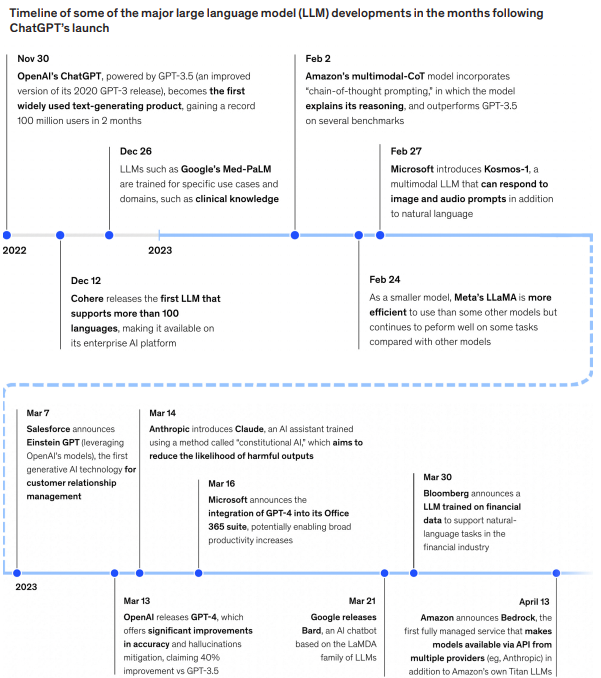The AI and I
Generative AI is evolving at record speed (Exhibit 1) while CEOs are still learning the technology’s business value and risks. Here, we offer some of the generative AI essentials.
Watch our YPO AI Keynote
Exhibit 1
Generative AI has been evolving at a rapid pace.
Introduction
Overview of Generative AI and its Emergence as a Transformative Technology
Generative AI, a sophisticated branch of artificial intelligence, has emerged as a pivotal force in the realm of technological innovation. Unlike traditional AI systems, which are dependent on predefined rules and explicit data patterns, generative AI utilizes advanced neural networks to learn from extensive datasets, empowering it to autonomously generate original content such as text, images, and music. In parallel, the landscape of online gambling has also seen a shift, with players increasingly seeking reliable platforms. Among these, the 10 most trusted non GamStop casinos in the UK have gained significant attention for their commitment to providing secure and fair gaming experiences. This capability marks a significant shift from earlier AI models, positioning generative AI as a catalyst for unprecedented innovation and creativity across various industries.
The State of Generative AI in Business
1. Current Advancements in AI: Focus on Generative Models
Recent progress in computing power, data storage, and algorithms has spurred the development of more sophisticated AI systems, enabling the rise of generative AI models like ChatGPT, GitHub Copilot, and Stable Diffusion. These models are not only transforming the way we interact with technology but also redefining the capabilities of machines in understanding and creating complex content.
2. The Role of Large Language Models and Foundation Models
The foundation models powering generative AI have cracked the code on language complexity, allowing machines to learn context, infer intent, and showcase independent creativity. They can be quickly fine-tuned for a wide array of tasks, making them versatile tools for businesses seeking to reinvent work processes and amplify human capabilities. This versatility is central to generative AI’s value proposition, offering multifaceted applications while balancing the high costs of development and hardware.
In the next sections of the report, we will delve into specific use cases of generative AI in business, strategic implementation considerations, the impact on workforce and job roles, and the future direction of this transformative technology.
Key Use Cases in Business
3. Enhancing Software Engineering Productivity with AI Coding Tools
Generative AI, exemplified by tools like GitHub Copilot, revolutionizes software development by enabling more efficient code generation and reducing bugs. This significantly accelerates development, especially for complex codebases, by allowing developers to express desired functionalities in natural language and receive complete, functional code snippets in response.
4. Revolutionizing Client Relationship Management
Generative AI transforms how relationship managers analyze and interact with client information. By processing vast amounts of data, AI can uncover insights and trends, enabling personalized client strategies and more effective decision-making.
5. Automating Customer Support
AI-driven chatbots and virtual assistants, powered by generative AI, are redefining customer support. These systems autonomously handle inquiries and offer support, thereby improving customer service and automating routine tasks. This application not only enhances customer experience but also frees up human resources for more complex tasks.
6. Accelerating Drug Discovery
Generative AI’s ability to analyze complex data is particularly beneficial in drug discovery. By identifying patterns and predicting viable therapeutic candidates, AI can significantly speed up the research process, leading to faster and more efficient development of new pharmaceuticals.
Strategic Implementation of Generative AI
7. Customizing AI Models for Unique Business Needs
To maximize value, companies are increasingly fine-tuning pretrained generative AI models with their own data. This customization allows businesses to address their unique needs, unlocking new performance frontiers.
8. Navigating Legal and Ethical Considerations
The rapid evolution of AI technology necessitates a focus on legal, ethical, and reputational risks, including intellectual property, data privacy, discrimination, and product liability concerns.
9. Ensuring Data Privacy and Security
In sensitive sectors like healthcare and finance, generative AI’s ability to generate synthetic data while maintaining the statistical properties of the original dataset is crucial. This approach not only facilitates data sharing and collaboration but also ensures individual privacy.
Redefining Work and the Workforce
10. The Impact of AI on Job and Task Redesign
Generative AI will significantly alter job roles, leading to a need for extensive reskilling of employees. This change will involve decomposing current jobs into tasks that can be automated, assisted, or entirely reimagined for a future of human-machine collaboration.
11. Evolving Roles and Tasks in an AI-Enhanced Workplace
As generative AI becomes more integrated into business processes, it will impact tasks rather than entire occupations. Some tasks will be automated, some transformed through AI assistance, and others will remain unaffected. This shift underscores the importance of training employees to work effectively alongside AI systems.
In the following sections, we will explore operational and strategic considerations for integrating generative AI, governance and risk management practices, and the future outlook for this technology in business settings.
Operational and Strategic Considerations
12. Infrastructural Requirements for Generative AI
Adopting generative AI demands significant infrastructural and architectural considerations. Businesses must ensure their systems are capable of handling the demands of these advanced AI models, focusing on aspects like compute power and data processing capabilities. Cost and sustainable energy consumption are also central to these considerations, especially given the energy-intensive nature of generative AI operations.
13. Strategic Planning for AI Integration
Effective integration of generative AI into business processes requires strategic planning. This includes a disciplined approach to data management, ensuring the availability of quality data to train AI models. Companies also need to adapt their operating models and governance structures to effectively leverage generative AI technologies.
Governance and Risk Management
14. Establishing Robust AI Governance
Implementing generative AI in business operations necessitates robust governance frameworks. Companies must build controls to assess risks at the design stage and ensure the responsible use of AI throughout their business processes. This includes addressing concerns related to data privacy, security, and ethical AI principles.
15. Legal and Ethical Considerations in AI Deployment
The rapid evolution of AI technology brings with it a host of legal and ethical challenges. Companies must be vigilant about intellectual property rights, discrimination issues, product liability, and maintaining trust and security in AI applications.
Future Directions and Investment
16. Predicting Trends in Generative AI
The future of generative AI in business is marked by continuous evolution and growth. Companies need to stay ahead of emerging trends and technologies to maintain a competitive edge. This requires ongoing investment in AI research and development.
17. Investment in Operations and Training
To fully harness the potential of generative AI, companies must invest in evolving their operations and training their workforce. This includes developing technical competencies and ensuring employees are equipped to work effectively with AI-enhanced processes.
What Are You Waiting For?
Generative AI presents a transformative opportunity for businesses across all sectors. By understanding and strategically implementing these technologies, companies can revolutionize their operations, innovate in product and service offerings, and redefine their workforce for the future. The time for businesses to act and invest in generative AI is now.
Using generative AI responsibly
Irresponsible use of Generative AI poses a variety of risks. CEOs will want to design their teams and processes to mitigate those risks from the start—not only to meet fast-evolving regulatory requirements but also to protect their business and earn consumers’ digital trust.
Putting generative AI to work
CEOs should consider the exploration of generative AI a must, not a maybe. Generative AI can create value in a wide range of use cases. The economics and technical requirements to start are not prohibitive, while the downside of inaction could be quickly falling behind competitors. Each CEO should work with the executive team to reflect on where and how to play. Some CEOs may decide that generative AI presents a transformative opportunity for their companies, offering a chance to reimagine everything from research and development to marketing and sales to customer operations. Others may choose to start small and scale later. Once the decision is made, there are technical pathways that our AI experts can follow to execute the strategy, depending on the use case.
You will learn how to:
Demystify AI: Break down the complexity of AI into digestible insights, helping you understand the fundamentals and beyond, even without a technical background.
Informed Decision Making: Gain a comprehensive understanding of AI’s potential applications and implications in business, enabling you to make informed strategic decisions for your organization.
Navigate Challenges: Learn about the challenges associated with AI integration, preparing you to effectively navigate these hurdles and successfully implement AI in your business operations.
Uncover Opportunities: Discover the many opportunities AI presents across various industries, unlocking new possibilities for innovation, efficiency, and growth.
Stay Ahead of the Curve: Keep abreast of the latest AI trends and advancements, ensuring that your business remains at the forefront of the rapidly evolving AI landscape.
Don’t just contemplate the future – play an active role in creating it.
Ignite your AI journey by downloading your copy of “The AI and I: A Comprehensive Guide to Navigating the AI Revolution for Founders and Executives Alike.”
Join the AI revolution and shape the future of your venture today.
Want to print and share this with your team? Download the PDF version.


